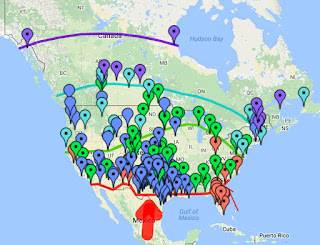You may have seen some strange people hanging around Columns IV on East Sunshine, all craning their necks up. If you joined them you too could have had a stiff neck and the awe inspiring vision of chimney swifts swarming and plunging into one of the columns.
 |
| Barn Swallows on a fence - REK |
People tend to lump swifts and barn swallows together but there are significant differences. They both migrate to South America and build their nests on vertical surfaces but that is where the resemblance ends. Swifts are unable to perch on a branch, wire or even land on a flat surface. They spend their entire life either flying or clinging to a perpendicular surface. They migrate to North America from Bolivia, Peru and the Upper Amazon River Basin in the spring, frequently seeking out their previous nesting sites. They are frequently described as "flying cigars" or "bow and arrows" for
their shape as they fly frantically across the sky.
Swifts historically have built their nests in hollow trees, forming a community that is frequently quite crowded. Life was good for a swift until the arrival of European settlers. As they expanded westward, they cut down trees, especially dead ones for fuel, a wholesale removal of nesting sites. The only good news was the stone chimneys they built on their cabins, providing a convenient nesting substitute.
The population of chimney swifts has declined precipitously across the majority of their range which extends across North America and Southern Eastern Canada. Home construction has changed and urban homes have started capping their chimneys to prevent nestings. Many of the old industrial smokestacks such as those in downtown Springfield have been torn down. Also a change in the insect populations due to insecticides has likely affected their diet.
 |
| Swifts can entertain your pet |
We always enjoy the return of the swifts to our chimneys. They make a faint twittering sound, barely audible through the fireplace doors, entertaining our schnauzer Shiann for hours at a time. They arrive in late spring after fireplace season and after their brood has fledged they leave our chimney to gather in large numbers in larger structures. Even then, they return to circle our house in the fall as an encore before heading to literally "hang out" with their friends.
 |
| Watershed Center towers under construction |
Now there is a movement to construct nesting towers for swifts. There are
plans and videos for these structures, lined with wood and to resemble a chimney without the fireplace. In Springfield this has been promoted and sponsored by Jim Fossard, an active GOAS (Greater Ozarks Audubon) member and passionate advocate for chimney swifts. Towers are now in place at the Watershed Center at Valley Water Mill Park and at the Springfield Botanical Gardens.
 |
| Chimney towers on a home |
You to can have both an active fireplace for use in the winter and a home for swifts in the summer as described
in this link. How? Don't cap your chimney and if you have a cap, take it off. Meanwhile, you can see the swifts in action at some of the few remaining large collecting sites next year. Bob and Beth Kick of our MN Chapter took
this video which shows the action at Columns IV this week. The show starts 30 minutes before sunset and although most of the swifts are headed south for the winter some may remain. Enjoy.
Thanks to John Schwartz of Birdpix.com for generously sharing his photographs, and to Jim Fossard for educating all of us.







































